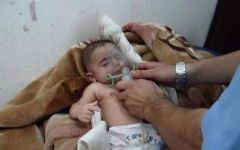Share
Human Rights Voices
While the UN devotes its human rights operations to the demonization of the democratic state of Israel above all others and condemns the United States more often than the vast majority of non-democracies around the world, the voices of real victims around the world must be heard.
Syrian Arab Republic, August 3, 2016
Toxic gas in the darkness: Assad regime drops chemical weapons on Syrian town ‘in revenge for shot down Russian helicopter’
Original source
In the darkness of the Syrian night, there was no way for the residents of Saraqib to see the green and yellow clouds of toxic gas. But they soon felt them.
Dozens of civilians - mainly women and children - were rushed to a makeshift hospital with their lungs burning from chlorine gas. Grown men writhed in pain while rescue workers struggled to fit an oxygen mask over the tiny face of a baby caught up in the attack.
The chemical weapon was dropped onto the town by the Assad regime late on Monday evening in an apparent act of revenge after nearby rebels shot down a Russian transport helicopter, killing five Russian troops.
The regime helicopter swept over the town of 30,000 and dropped at least two canisters of liquid chlorine, a chemical with a thousand benign uses now turned into a weapon of war by Syria's government against its own people.
"After shelling, besieging and killing civilians and perpetrating war crimes on them, the Assad regime has resorted once again, and in breach of UN resolutions 2118 and 2235, to using chemical substances and toxic gasses," said the Syrian National Coalition, an umbrella opposition group.
Around 33 people were treated for chlorine inhalation but all survived, according to a local rescue group.
The attack came nearly four years to the day since President Barack Obama warned that chemical weapons were a "red line" and their use would not be tolerated by the international community.
Since then the Assad regime has been accused of regularly deploying chemical weapons on the battlefield and against civilians, most devastatingly in 2013 when an attack on a Damascus suburb killed more than a thousand and brought the US to the verge of intervening before the White House backed down.
Just this week Human Rights Watch released a report detailing what it said was "strong evidence" of three separate attacks carried out by regime troops using chlorine which injured more than 500 people.
"Syria's apparent use of chlorine gas as a weapon – not to mention targeting of civilians – is a plain violation of international law," said Nadim Houry, the group's deputy Middle East and North Africa director.
The Islamic State (Isil) has mimicked its tactics and now also uses crude chemical weapons. As recently as this weekend, jihadist fighters fired chlorine canisters against Kurdish Peshmerga troops fighting near Mosul.
The attack on Saraqib came as fighting continued to rage in Aleppo, Syria's largest city. Government forces have cut off several opposition-held neighborhoods and rebel fighters are in the midst of a counter-offensive to try to break the regime stranglehold.
Around 18 women and children were among 30 people killed by rebel shells fired into a regime-held area of the city, according to the Syrian Observatory for Human Rights.
The regime and its Russian allies responded with relentless waves of airstrikes on Monday night in an effort to drive back the combined force of rebel fighters and jihadists. By Tuesday, the bombing appeared to have at least slowed the advance of anti-government forces.
Around 250,000 civilians are believed to still be inside the city.
Monday night's chlorine gas attack came hours after a Russian Mi-8 helicopter was shot down around ten miles outside of Saraqib by an unknown rebel group.
The Russian defense ministry confirmed that five people had been killed in what was the largest acknowledged loss of Russian life since its operations began in Syria last year. Other Russian personnel are believed to have been killed but their deaths were kept secret by the Russian government.
It was not the first time that Saraqib has been hit by a gas attack.
In 2013 government helicopters are believed to have dropped chemical weapons on the town and the Syrian Civil Defence group said it had recorded at least nine chlorine gas attacks in the surrounding Idlib province since fighting began in 2011.
The Syrian defense ministry could not be reached for comment.
Hamish de Bretton-Gordon, a chemical weapons expert and advisor to NGOs in Syria, said the Saraqib attack highlighted the need for the West to enforce a no-fly zone against Syrian regime helicopters, which are the main vehicle for chemical attacks.
"With the amount of radar coverage the coalition has over Syria it would very easy to track these helicopters which cause so much devastation and prevent them from flying," Mr de Bretton-Gordon said.
He suggested they could be shot down with anti-aircraft missiles fired from British or US warships in the Mediterranean therefore keeping coalition pilots out of the range of Syria's sophisticated air defense systems.
The regime usually simply drops barrels of liquid chlorine onto its targets. The barrels split open on impact and the chemical quickly turns to vapour and forms a green or yellow cloud.
The clouds are relatively easy to avoid during daylight but during night attacks like the one in Saraqib the victims often do not see them until it is too late.

